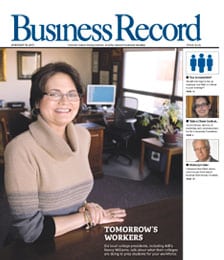Local TV stations battle costs of digital broadcasting

Shoppers flooded retail stores in the post-Christmas sales rush, some of whom dumped hundreds or even thousands of dollars into large-screen, high-definition-ready television sets. Though some might have suffered from buyer’s remorse, their total expenses pale in comparison to the millions spent by television stations to provide high definition programming to viewers.
“It cost us a little over $2 million to put the [digital] signal up on the air,” said Brad Olk, chief engineer at WHO-TV 13, which has been on in the air in digital format since January 2002. “And we’ve got additional operating costs. For the digital channel, we’re in the $7,000 to $8,000 range per month for electricity.”
Broadcast television stations are required, under a 1996 Federal Communications Commission decision, to convert to digital broadcasting, which will replace analog broadcasting in the future. Stations are currently broadcasting in analog and simulcasting a required number of hours on a second digital channel. Channel 13 is on the air in digital 24 hours a day, creating the added expenses of operating two channels simultaneously.
“It’s a very substantial capital investment and one that broadcasters are making for the future, because it’s not like digital is bringing in more viewers – it’s splitting the viewership between the two (channels),” said Bob Day, operations manager at KCCI.
But stations do not necessarily consider it a long-term investment. In the future (a specific date has not been determined) the FCC will order stations to shut off their analog channels and broadcast only on the digital channels. The equipment once used to operate a second channel will become obsolete.
“I’m looking at about one and a quarter million dollars worth of equipment that will be useless to us when we have to turn one channel off,” said Olk.
The FCC originally authorized a certain power level for each station in order to replicate their existing coverage areas. Olk said WHO was originally authorized for 550 kilowatts and has since applied for and received permission to increase to 1 million watts of power.
Day said KCCI has yet to increase to full power, but intends to do so by June or July, which will keep the station in full compliance with the FCC. The goal all along, he added, has been to reach the same number of viewers with digital technology as it had been able to with analog, which requires less power.
“We’ve been operating at about one-third of our authorized power and that still covers about 80 to 85 percent of our service area,” he said. KDSM Fox 17 and Iowa Public Television are both broadcasting at full power.
WOI-TV 5 President Ray Cole said the local ABC affiliate is broadcasting a low-power standard definition signal and has been holding off on the build-out to full-power high definition due to the fact that the FCC assigned the station with an “out of core” digital channel, similar to other stations nationwide because, as the FCC was doubling the number of channels with digital and analog, there was no room for all of the stations to fit into the core channels.
“The FCC (in September 2004) issued a Report and Order which, for the first time, laid out a logical plan for all stations to complete the transition from analog to digital,” Cole said. “We will be upgrading our facilities now that the FCC has delineated the transition will be completed.” The plan adopted a multi-step channel election and “repacking” process under which broadcasters will select their digital channel in the core.
Jeff Traviss, a buyer at Traviss Audio Video, said 2004 was “a banner year” for sales of televisions with high-definition capabilities. Traviss said many customers have been drawn in to buying a new television set after watching a football or basketball game in high definition at a friend’s home, attracted by HDTV’s better image and sound.
The price of these sets has also seen a decline over the last year. Traviss said many HDTV-complete sets, which have a digital decoder built in, now cost about $1,200, compared with $2,000 a year ago.
“Last year only one local channel was broadcasting sporadically,” he said. “But this year with all the stations [broadcasting digitally] and the weekend sports in high definition, that has caused it to explode.”
Some smaller high-definition television sets cost as little as $600, though viewers will still need a small antenna to pick up HDTV broadcasts. Traviss said many customers believe they have to subscribe to cable or satellite television in order to view HDTV, which he said is simply not true.
“I think the biggest thing that people aren’t aware of is how much free high def they can get with rabbit ears or an antenna,” he said.
But Olk said that, though broadcasters “jumped in and did what we needed to do,” consumer electronics manufacturers have moved a bit slower in easing the conversion process.
“Prices aren’t coming down as much and people aren’t buying it as fast ast the consumer electronics people told the government they would,” he said. He said original estimates claimed that 80 to 85 percent of viewers would have HDTV capabilities by 2006, and Olk is sure that number has not reached 50 percent.







